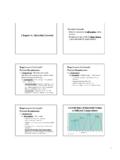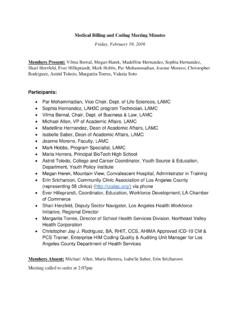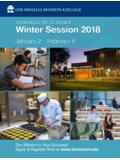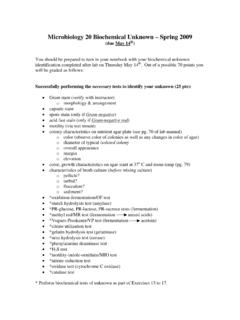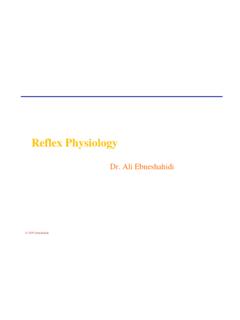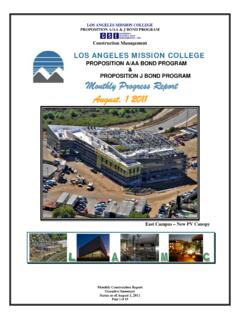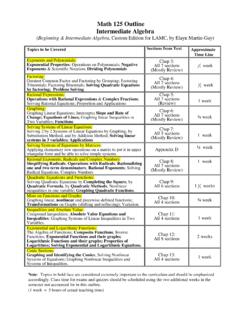Transcription of Chapter 7: Control of Microbial Growth
1 Control of Microbial Growth : Introduction 4 Early civilizations practiced salting, smoking, Chapter 7: Control of pickling, drying, and exposure of food and clothing to sunlight to Control Microbial Growth . Microbial Growth 4 Use of spices in cooking was to mask taste of spoiled food. Some spices prevented spoilage. 4 In mid 1800s Semmelweiss and Lister helped developed aseptic techniques to prevent contamination of surgical wounds. Before then: Nosocomial infections caused death in 10% of surgeries. Up to 25% mothers delivering in hospitals died due to infection Control of Microbial Growth : Control of Microbial Growth : Definitions Definitions Sterilization: Killing or removing all forms of Disinfection: Reducing the number of pathogenic Microbial life (including endospores) in a material microorganismsto the point where they no longer or an object.
2 Cause diseases. Usually involves the removal of vegetative or non-endospore forming pathogens. Heating is the most commonly used method of sterilization. May use physical or chemical methods. u Disinfectant: Applied to inanimate objects. Commercial Sterilization: Heat treatment that u Antiseptic: Applied to living tissue (antisepsis). kills endospores of Clostridium botulinum the u Degerming : Mechanical removal of most microbes in a causative agent of botulism, in canned food. limited area. Example: Alcohol swab on skin. Does not kill endospores of thermophiles, which u Sanitization: Use of chemical agent on food-handling are not pathogens and may grow at temperatures equipment to meet public health standards and minimize above 45o C. chances of disease transmission. : Hot soap & water. Control of Microbial Growth : Control of Microbial Growth : Definitions Definitions Sepsis: Comes from Greek for decay or putrid.
3 Bacteriostatic Agent: An agent that inhibits the Indicates bacterial contamination. Growth of bacteria, but does not necessarily kill Asepsis: Absence of significant contamination. them. Suffix stasis: To stop or steady. Aseptic techniques are used to prevent Germicide : An agent that kills certain contamination of surgical instruments, medical micoorganisms. personnel, and the patient during surgery. u Bactericide: An agent that kills bacteria. Most do not kill endospores. Aseptic techniques are also used to prevent u Viricide: An agent that inactivates viruses. bacterial contamination in food industry. u Fungicide: An agent that kills fungi. u Sporocide: An agent that kills bacterial endospores of fungal spores. 1. Control of Microbial Growth : Control of Microbial Growth : Rate of Microbial Death Rate of Microbial Death When bacterial populations are heated or treated Several factors influence the effectiveness of antimicrobial chemicals, they usually die at a antimicrobial treatment.
4 Constant rate. 1. Number of Microbes: The more microbes present, the more time it takes to eliminate population. 2. Type of Microbes: Endospores are very difficult to destroy. Vegetative pathogens vary widely in susceptibility to different methods of Microbial Control . 3. environmental influences: Presence of organic material (blood, feces, saliva) tends to inhibit antimicrobials, pH etc. 4. Time of Exposure: Chemical antimicrobials and radiation treatments are more effective at longer times. In heat treatments, longer exposure compensates for lower temperatures. Phsysical Methods of Microbial Phsysical Methods of Microbial Control : Control : Heat: Kills microorganisms by denaturing their Moist Heat: Kills microorganisms by coagulating enzymes and other proteins. Heat resistance their proteins. varies widely among microbes. In general, moist heat is much more effective than u Thermal Death Point (TDP) : Lowest temperature at dry heat.
5 Which all of the microbes in a liquid suspension will be u Boiling: Heat to 100 oC or more at sea level. Kills vegetative killed in ten minutes. forms of bacterial pathogens, almost all viruses, and fungi u Thermal Death Time (TDT): Minimal length of time in and their spores within 10 minutes or less. Endospores and which all bacteria will be killed at a given temperature. some viruses are not destroyed this quickly. However brief u Decimal Reduction Time (DRT): Time in minutes at boiling will kill most pathogens. which 90% of bacteria at a given temperature will be u Hepatitis virus: Can survive up to 30 minutes of boiling. killed. Used in canning industry. u Endospores: Can survive up to 20 hours or more of boiling. Phsysical Methods of Microbial Autoclave: Closed Chamber with High Control : Temperature and Pressure Moist Heat (Continued): Reliable sterilization with moist heat requires temperatures above that of boiling water.
6 U Autoclave: Chamber which is filled with hot steam under pressure. Preferred method of sterilization, unless material is damaged by heat, moisture, or high pressure. u Temperature of steam reaches 121o C at twice atmospheric pressure. u Most effective when organisms contact steam directly or are contained in a small volume of liquid. u All organisms and endospores are killed within 15 minutes. u Require more time to reach center of solid or large volumes of liquid. 2. Phsysical Methods of Microbial Phsysical Methods of Microbial Control : Control : Moist Heat (Continued): Dry Heat: Kills by oxidation effects. u Pasteurization: Developed by Louis Pasteur to prevent the u Direct Flaming: Used to sterilize inoculating loops and spoilage of beverages. Used to reduce microbes responsible needles. Heat metal until it has a red glow. for spoilage of beer, milk, wine, juices, etc.
7 U Incineration: Effective way to sterilize disposable items u Classic Method of Pasteurization: Milk was exposed to 65o C for 30 (paper cups, dressings) and biological waste. minutes. u Hot Air Sterilization: Place objects in an oven. Require 2. u High Temperature Short Time Pasteurization (HTST): Used today. Milk is exposed to 72o C for 15 seconds. hours at 170 oC for sterilization. Dry heat is transfers heat less u Ultra High Temperature Pasteurization (UHT): Milk is treated at effectively to a cool body, than moist heat. 140o C for 3 seconds and then cooled very quickly in a vacuum chamber. Advantage: Milk can be stored at room temperature for several months. Phsysical Methods of Microbial Phsysical Methods of Microbial Control : Control : Filtration: Removal of microbes by passage of a Low Temperature: Effect depends on microbe and liquid or gas through a screen like material with small treatment applied.
8 Pores. Used to sterilize heat sensitive materials like u Refrigeration: Temperatures from 0 to 7 oC. Bacteriostatic vaccines, enzymes, antibiotics, and some culture effect. Reduces metabolic rate of most microbes so media. they cannot reproduce or produce toxins. u High Efficiency Particulate Air Filters (HEPA): Used in u Freezing: Temperatures below 0oC. operating rooms and burn units to remove bacteria from air. u Flash Freezing : Does not kill most microbes. u Membrane Filters: Uniform pore size. Used in industry and u Slow Freezing : More harmful because ice crystals disrupt research. Different sizes: cell structure. u and Pores: Used to filter most bacteria. Don't retain u Over a third of vegetative bacteria may survive 1 year. spirochetes, mycoplasmasand viruses. u Most parasites are killed by a few days of freezing. u um Pores: Retain all viruses and some large proteins.
9 Phsysical Methods of Microbial Phsysical Methods of Microbial Control : Control : Dessication: In the absence of water, microbes Osmotic Pressure: The use of high concentrations of cannot grow or reproduce, but some may remain salts and sugars in foods is used to increase the viable for years. After water becomes available, they osmotic pressure and create a hypertonic start growing again. environment. Susceptibility to dessication varies widely: Plasmolysis: As water leaves the cell, plasma u Neisseria gonnorrhea: Only survives about one hour. membrane shrinks away from cell wall. Cell may not u Mycobacterium tuberculosis: May survive several months. die, but usually stops growing. u Viruses are fairly resistant to dessication . u Yeasts and molds: More resistant to high osmotic pressures. u Clostridium spp. and Bacillus spp.: May survive decades.
10 U Staphylococci spp. that live on skin are fairly resistant to high osmotic pressure. 3. Phsysical Methods of Microbial Control : Forms of Radiation Radiation: Three types of radiation kill microbes: 1. Ionizing Radiation: Gamma rays, X rays, electron beams, or higher energy rays. Have short wavelengths (less than 1 nanometer). Dislodge electrons from atoms and form ions. Cause mutations in DNA and produce peroxides. Used to sterilize pharmaceuticals and disposable medical supplies. Food industry is interested in using ionizing radiation. Disadvantages: Penetrates human tissues. May cause genetic mutations in humans. Phsysical Methods of Microbial Phsysical Methods of Microbial Control : Control : Radiation: Three types of radiation kill microbes: Radiation: Three types of radiation kill microbes: 2. Ultraviolet light (Nonionizing Radiation): 3.
